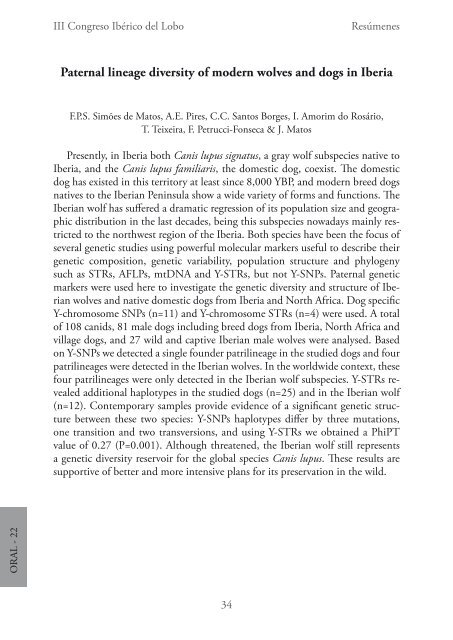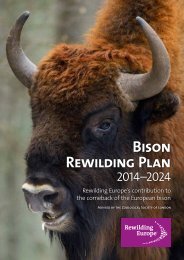III Congreso Ib%C3%A9rico del Lobo
III Congreso Ib%C3%A9rico del Lobo
III Congreso Ib%C3%A9rico del Lobo
Create successful ePaper yourself
Turn your PDF publications into a flip-book with our unique Google optimized e-Paper software.
ORAL - 22<br />
<strong>III</strong> <strong>Congreso</strong> Ibérico <strong>del</strong> <strong>Lobo</strong> Resúmenes<br />
Paternal lineage diversity of modern wolves and dogs in Iberia<br />
F.P.S. Simões de Matos, A.E. Pires, C.C. Santos Borges, I. Amorim do Rosário,<br />
T. Teixeira, F. Petrucci-Fonseca & J. Matos<br />
Presently, in Iberia both Canis lupus signatus, a gray wolf subspecies native to<br />
Iberia, and the Canis lupus familiaris, the domestic dog, coexist. The domestic<br />
dog has existed in this territory at least since 8,000 YBP, and modern breed dogs<br />
natives to the Iberian Peninsula show a wide variety of forms and functions. The<br />
Iberian wolf has suffered a dramatic regression of its population size and geographic<br />
distribution in the last decades, being this subspecies nowadays mainly restricted<br />
to the northwest region of the Iberia. Both species have been the focus of<br />
several genetic studies using powerful molecular markers useful to describe their<br />
genetic composition, genetic variability, population structure and phylogeny<br />
such as STRs, AFLPs, mtDNA and Y-STRs, but not Y-SNPs. Paternal genetic<br />
markers were used here to investigate the genetic diversity and structure of Iberian<br />
wolves and native domestic dogs from Iberia and North Africa. Dog specific<br />
Y-chromosome SNPs (n=11) and Y-chromosome STRs (n=4) were used. A total<br />
of 108 canids, 81 male dogs including breed dogs from Iberia, North Africa and<br />
village dogs, and 27 wild and captive Iberian male wolves were analysed. Based<br />
on Y-SNPs we detected a single founder patrilineage in the studied dogs and four<br />
patrilineages were detected in the Iberian wolves. In the worldwide context, these<br />
four patrilineages were only detected in the Iberian wolf subspecies. Y-STRs revealed<br />
additional haplotypes in the studied dogs (n=25) and in the Iberian wolf<br />
(n=12). Contemporary samples provide evidence of a significant genetic structure<br />
between these two species: Y-SNPs haplotypes differ by three mutations,<br />
one transition and two transversions, and using Y-STRs we obtained a PhiPT<br />
value of 0.27 (P=0.001). Although threatened, the Iberian wolf still represents<br />
a genetic diversity reservoir for the global species Canis lupus. These results are<br />
supportive of better and more intensive plans for its preservation in the wild.<br />
34



